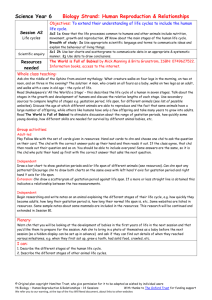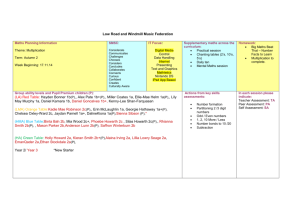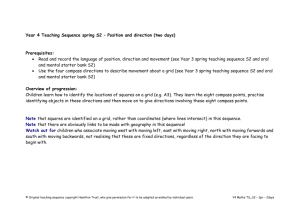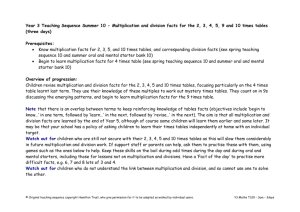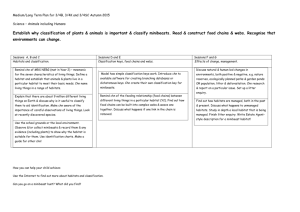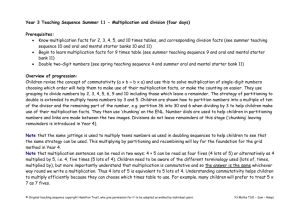wc 23.6.15 – multiplication and division
advertisement
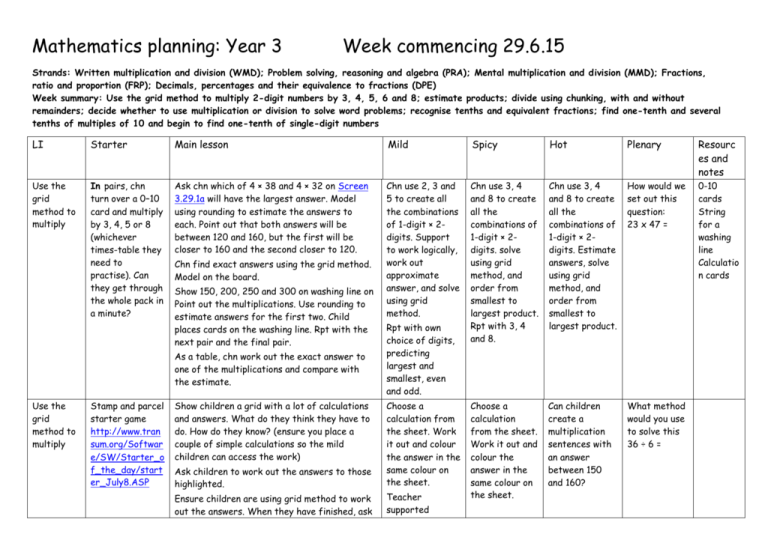
Mathematics planning: Year 3 Week commencing 29.6.15 Strands: Written multiplication and division (WMD); Problem solving, reasoning and algebra (PRA); Mental multiplication and division (MMD); Fractions, ratio and proportion (FRP); Decimals, percentages and their equivalence to fractions (DPE) Week summary: Use the grid method to multiply 2-digit numbers by 3, 4, 5, 6 and 8; estimate products; divide using chunking, with and without remainders; decide whether to use multiplication or division to solve word problems; recognise tenths and equivalent fractions; find one-tenth and several tenths of multiples of 10 and begin to find one-tenth of single-digit numbers LI Starter Main lesson Mild Spicy Hot Plenary Resourc es and notes Use the grid method to multiply In pairs, chn turn over a 0–10 card and multiply by 3, 4, 5 or 8 (whichever times-table they need to practise). Can they get through the whole pack in a minute? Ask chn which of 4 × 38 and 4 × 32 on Screen 3.29.1a will have the largest answer. Model using rounding to estimate the answers to each. Point out that both answers will be between 120 and 160, but the first will be closer to 160 and the second closer to 120. Chn use 2, 3 and 5 to create all the combinations of 1-digit × 2digits. Support to work logically, work out approximate answer, and solve using grid method. Chn use 3, 4 and 8 to create all the combinations of 1-digit × 2digits. solve using grid method, and order from smallest to largest product. Rpt with 3, 4 and 8. Chn use 3, 4 and 8 to create all the combinations of 1-digit × 2digits. Estimate answers, solve using grid method, and order from smallest to largest product. How would we set out this question: 23 x 47 = 0-10 cards String for a washing line Calculatio n cards Choose a calculation from the sheet. Work it out and colour the answer in the same colour on the sheet. Can children create a multiplication sentences with an answer between 150 and 160? What method would you use to solve this 36 ÷ 6 = Chn find exact answers using the grid method. Model on the board. Show 150, 200, 250 and 300 on washing line on Point out the multiplications. Use rounding to estimate answers for the first two. Child places cards on the washing line. Rpt with the next pair and the final pair. As a table, chn work out the exact answer to one of the multiplications and compare with the estimate. Use the grid method to multiply Stamp and parcel starter game http://www.tran sum.org/Softwar e/SW/Starter_o f_the_day/start er_July8.ASP Show children a grid with a lot of calculations and answers. What do they think they have to do. How do they know? (ensure you place a couple of simple calculations so the mild children can access the work) Rpt with own choice of digits, predicting largest and smallest, even and odd. Ask children to work out the answers to those highlighted. Choose a calculation from the sheet. Work it out and colour the answer in the same colour on the sheet. Ensure children are using grid method to work out the answers. When they have finished, ask Teacher supported Mathematics planning: Year 3 Week commencing 29.6.15 children to pick another and work that out. Can they compare the two. To divide using a numberine, Ask chn how many 3s in 6. So how many threes in sixty? Write 20 × 3 = 60. Rpt with 4s in 12. Call out similar pairs of divisions, chn agree corresponding multiplications. Teaching: Chn predict which of 59 ÷ 4 and 85 ÷ 5 has a remainder. Emphasise how we can use multiplication to solve division and reveal the multiplication with a hole. Remind chn how to sketch a line and use Chunky Chimp to model solving 59 ÷ 4 / ☐ × 4 = 59. To multiply and divide using a written method Give children a multiplication and division question. Which would give you the smaller answer and why? Give children a multiplication that involves money. Ask them to think about how you would partition the number and then add it together. Give each group a calculation to complete. Repeat the process for division using ml. LI: To solve work problems relating to x and÷. Throw dice twice and multiply the resulting two numbers together. Provide children with an example word problem. How would they solve it? What clues tell you it is a multiplication/division? Chn rpt to find exact answer to 85 ÷ 5. Task: In pairs, chn discuss which two divisions on the next slide won't have a remainder. Teaching: Create six groups. Each work out one of the divisions using Chunky Chimp. Were chn's predictions correct? Chn answer the first 12 questions on powerpoint ʻDivision using chunkingʼ, using Chunky Chimp to solve divisions, with and without remainders. Chn answer questions 1–16 on powerpoint ʻDivision using chunkingʼ, using Chunky Chimp to solve divisions, with and without remainders. Chn answer questions 5–17 on powerpoint ʻDivision using chunkingʼ, first predicting whether there will be a remainder. Complete mixed operation calculations 2,3 and 5 x tables Complete mixed operation calculations 2, 3, 4, 5 and 8 x tables Provide children with mixed operation calculations that involve money, length and weight Complete word problems relating to 2, 3 and 5 x tables Complete word problems relating to all year 3 x tables. Complete word problems relating to all year 3 x tables. Ext: 2 step problems Ask children to find the numbers using the Complete worksheets by sticking them Provide children with questions written Explain task What numbers would you need to look at and what are the clues that tell you it is a x or /? Allow children time to solve the calculations and then ask them to stick in an example and solve it together. Ensure children have time to highlight the important facts of each word problem LI: To represent and solve problems Read: Once is a Snail, Ten is a Crab to the Give children and example of a multiplication and division problems relating to the book; One is a Snail, Ten is a Crab. Ensure they are What’s the same and what’s different about these calculations. 2 x 28 84 ÷ 4 = Mathematics planning: Year 3 relating to x and ÷ children the day before the lesson. Ask children to think of different ways to make 20 Week commencing 29.6.15 differentiated. (This is already done on the powerpoint slide) Allow children time to talk about each problem before they attempt to tackle it. Model how to solve it on the board. Explain the task to children and provide each with procedural Success Criteria to aid them in tackling each problem. pictures and then x or ÷ them by 3 and 5 into their books. This is the beginnings of understanding algebra. algebraically and ask them to solve each calculation




